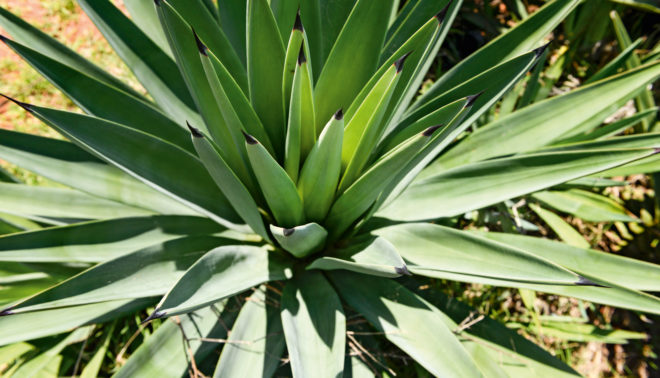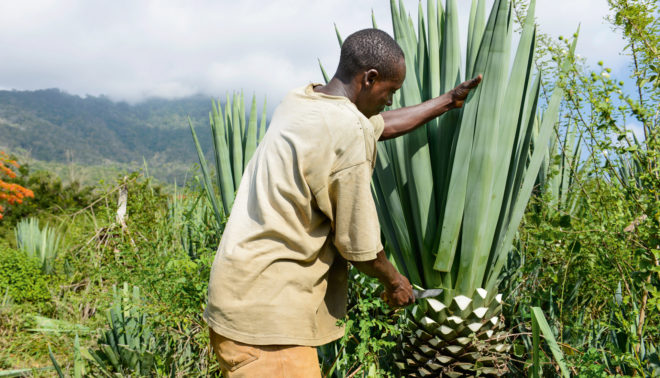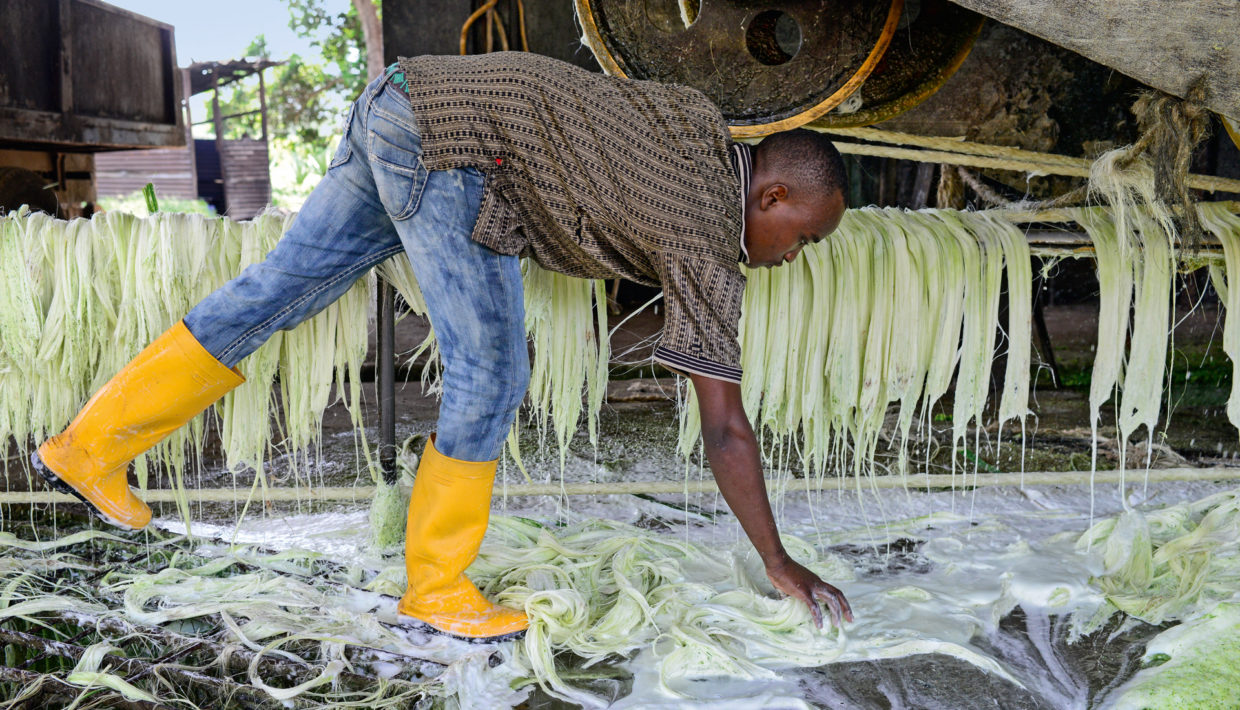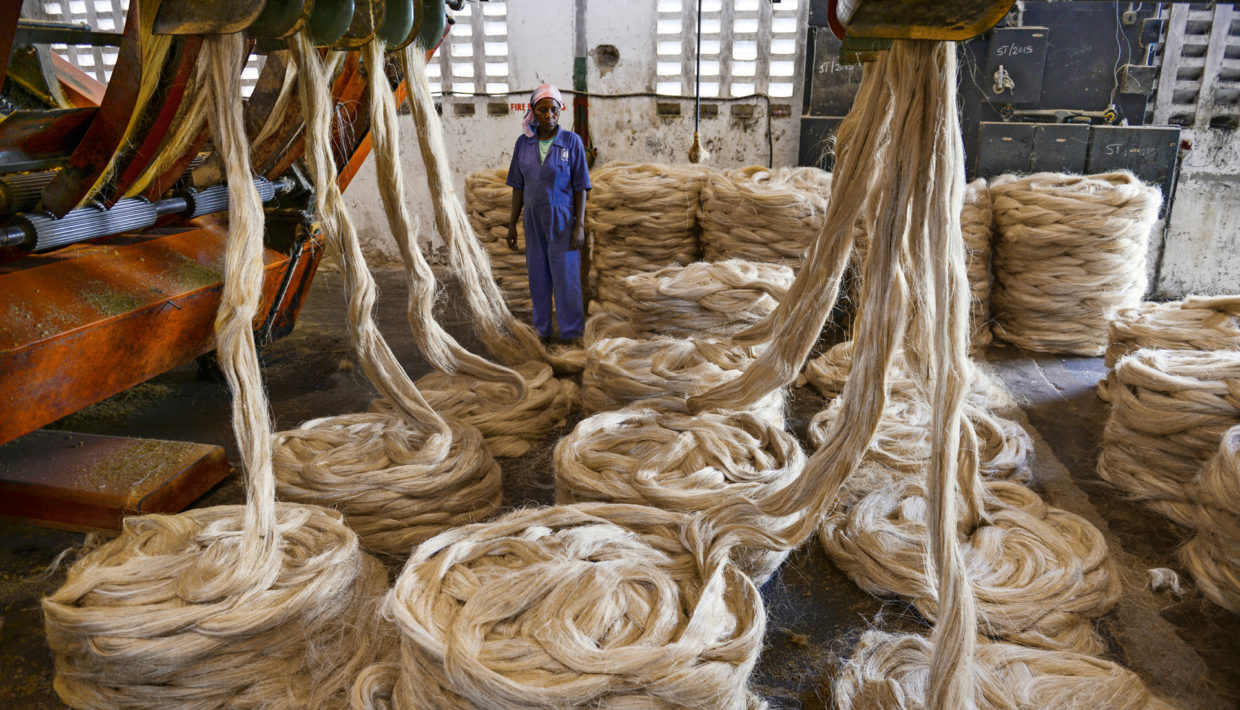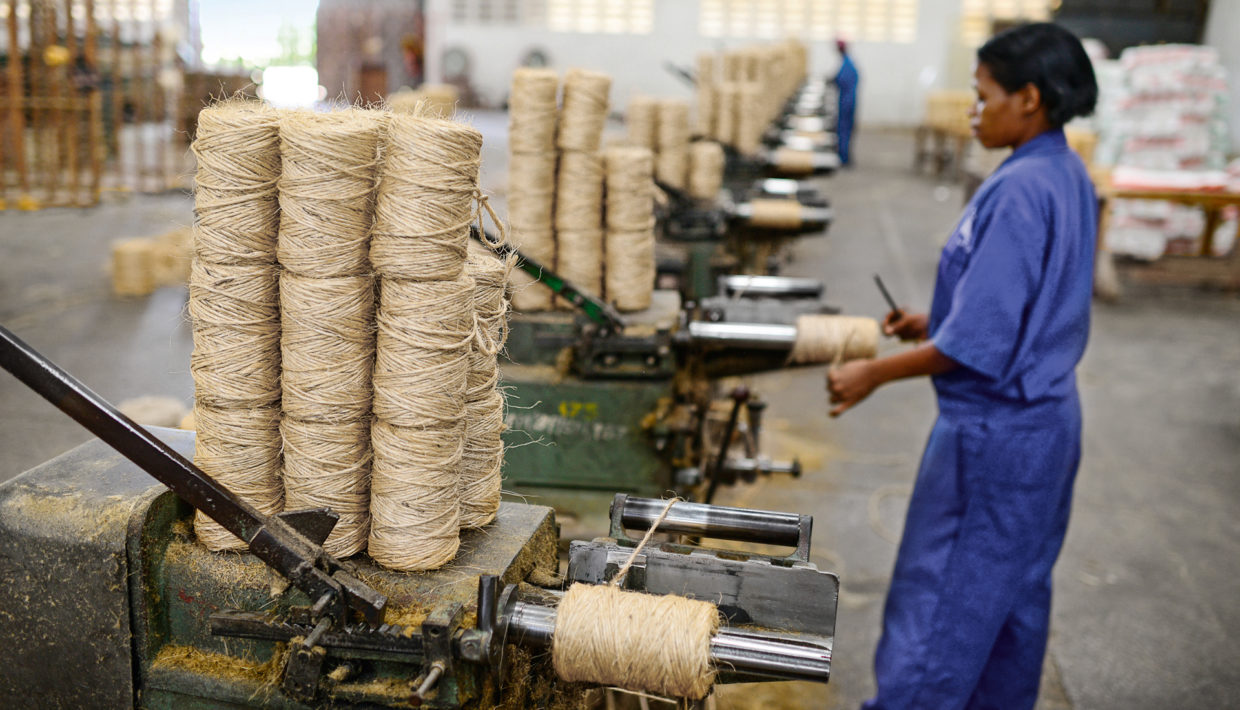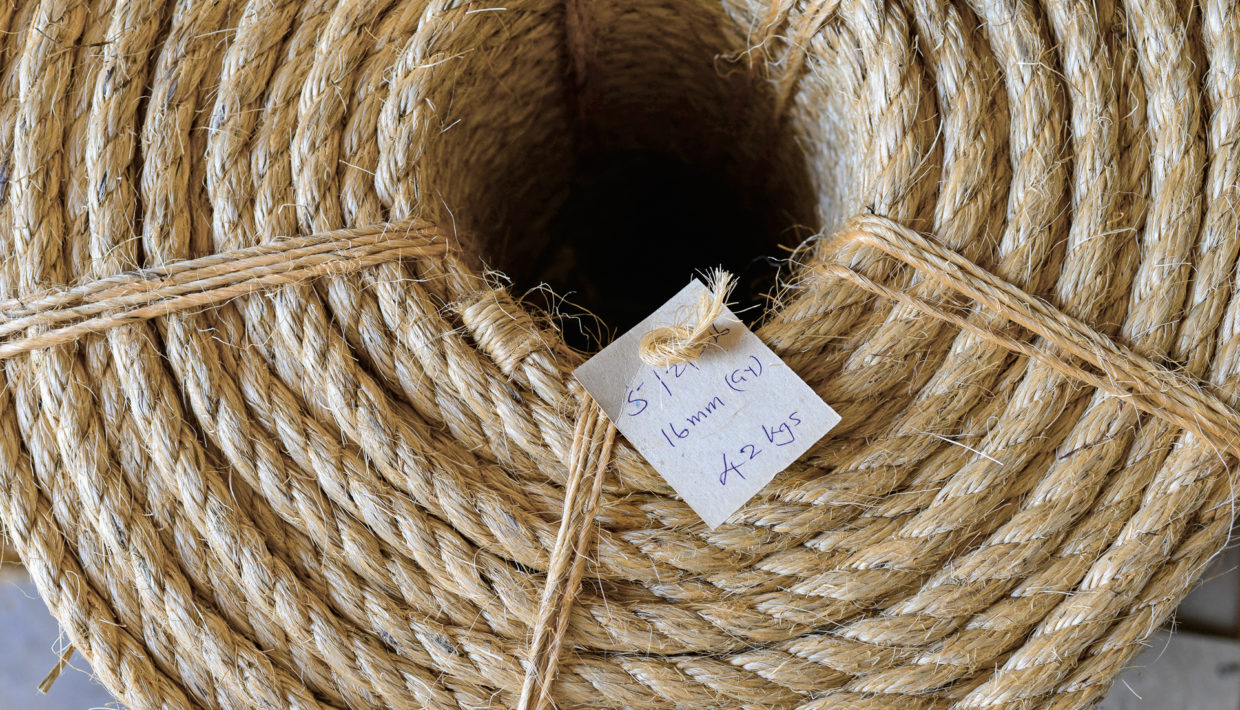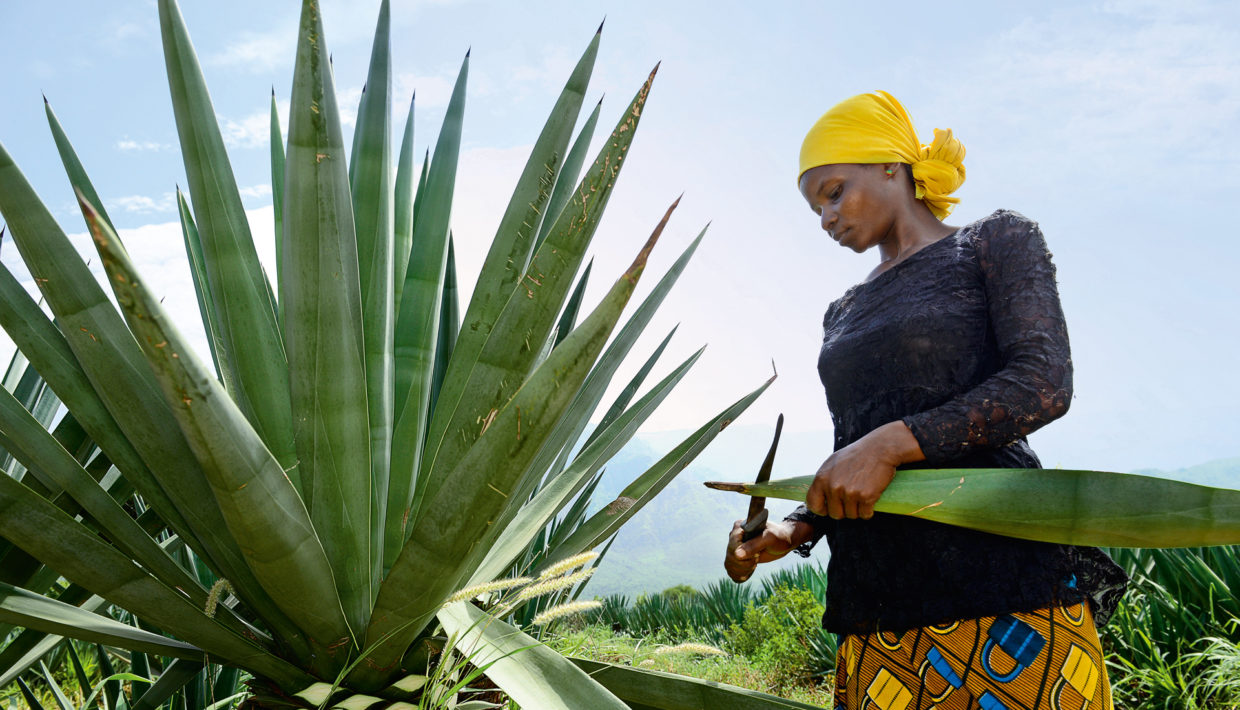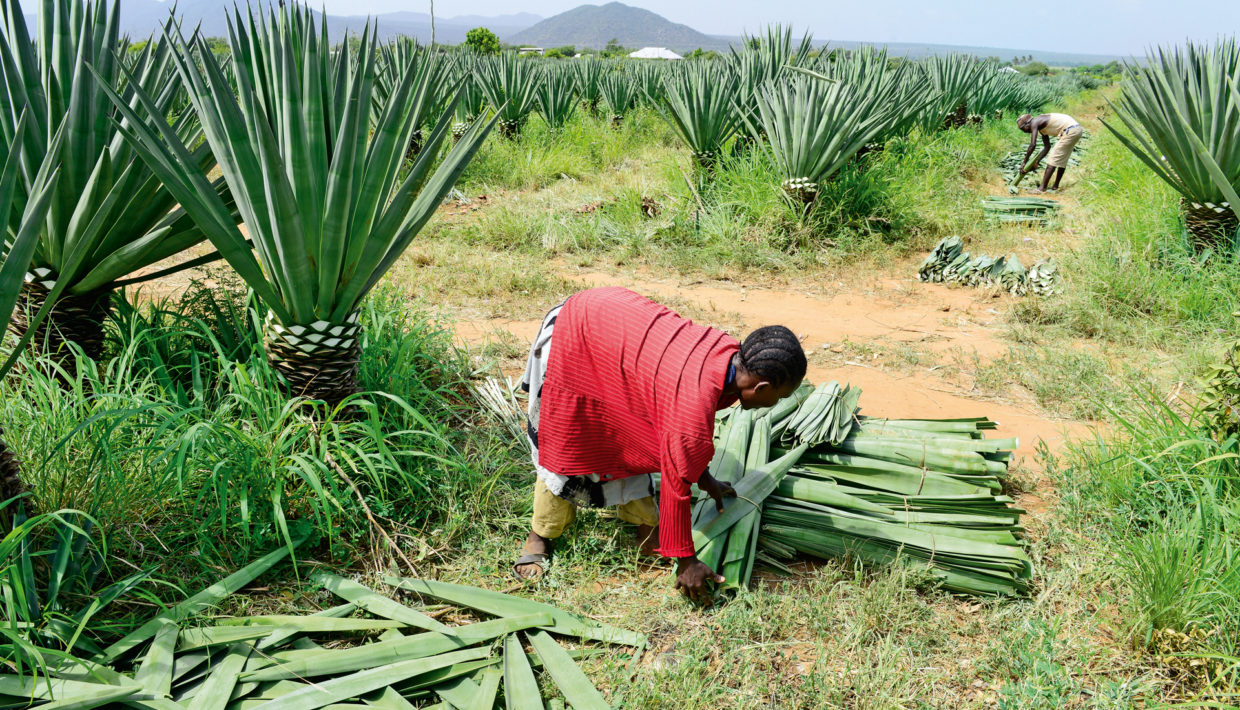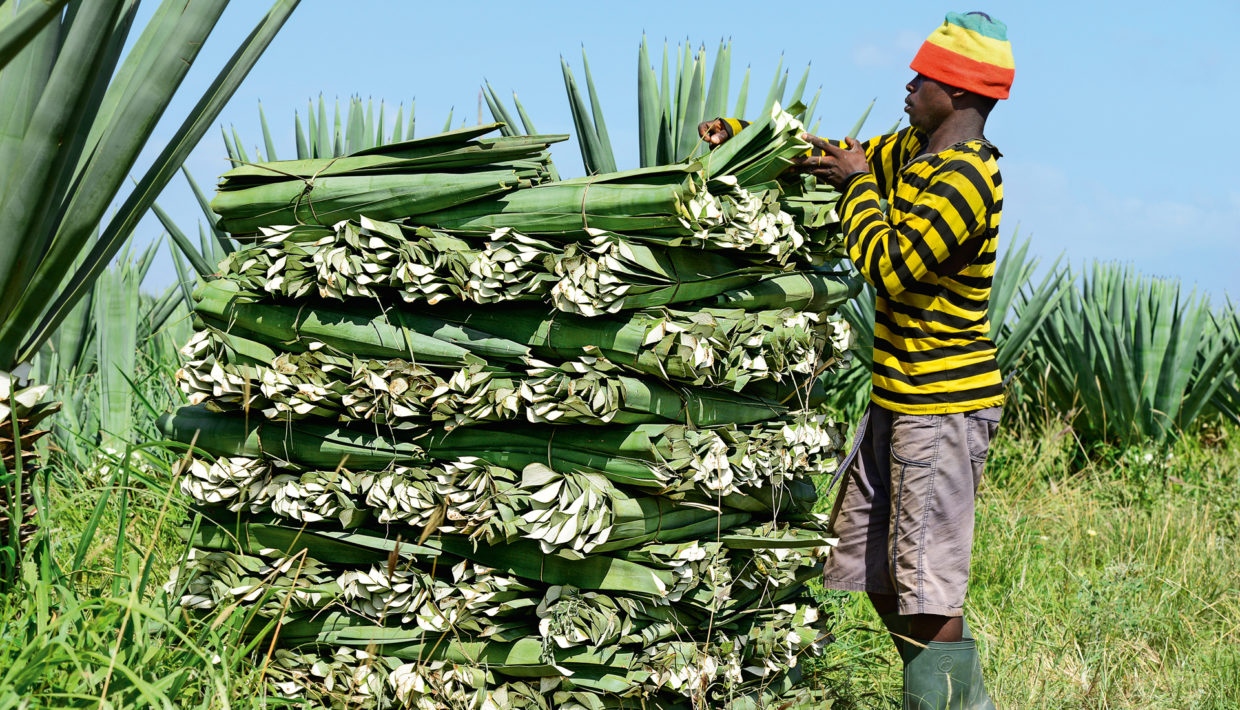This man is a phenomenon. Most men of his age would be enjoying a well-earned retirement – but not him! When he left the state-run Tanzania Sisal Authority almost 30 years ago, he immediately began his own adventure with sisal. He purchased an abandoned sisal plantation at the foot of the Usambara Mountains in northern Tanzania for a cheap price. The 1,750ha site was covered with weeds growing rampantly, many of the agave plants were old and gone to seed and no longer fit for sisal production. Now the sisal plantation is all up and running again. More than 300 employees are now cultivating and processing the prickly green leaves of the Agave sisalana plant, of which the fibres were once famously known as the “white gold of Africa”.

Damien Ruhinda, sells and produces sisal in Tanga, Tanzania.
Demand for sisal is growing
The talk is all about Damien Ruhinda. He is over 80 years old but looks more like 60. “Yes, sisal is a tough thing”, he says, in the small office of D. D. Ruhinda & Company Limited in Tanga. “Firstly”, he says drily, “selling is no problem, it’s the production which is the real challenge.” But his mission goes beyond his own private commercial objectives: He wants to play his part in returning sisal fibre, which was once Tanzania’s most important export, to its former glory.
But to achieve this goal, Tanzania’s entire sisal industry, from the plantations to the downstream processing operations, still has a long way to go. Of course the outlook is not bad now because international demand for the natural fibre is growing again. In addition to the domestic market, Mr Ruhinda refers to customers in the Arab countries and China, as well as in Europe.
The bulk of sisal exports currently go to the Arab countries, where large quantities of the fibres are used as structural material in plaster construction work. Another portion goes into worldwide carpet production, and it is also used in agriculture and shipping – sectors in which, after many years of decline, worldwide demand is also picking up again. For example, shipping organisations in Australia and New Zealand are seeking a ban on the use of synthetic ropes because they are not biodegradable and hence pollute the seas.
Ambitious goals

Tanga is a relaxed, almost sleepy looking tropical port city on the Indian Ocean where mosques and Christian churches are peaceful neighbours. From here, the sisal produced in northern Tanzania is exported overseas. During colonial times, the golden fibres were carried to Tanga by rail – but this era is long gone. The old goods station now looks more like a neglected industrial museum than a functional transport hub.
Selling is no problem, it´s the production which is the real challenge.
Damien Ruhinda
Today the raw fibres and yarns from the plantations and spinning mills are ferried to the port city in trucks. “Mkonge ni Tanga, na Tanga ni Mkonge” is written in large letters on the sign in front of the building from the British colonial period, which houses the Tanzania Sisal Board. Translated from the national language, Kiswahili, this means: “Sisal is Tanga and Tanga is sisal”.
This underscores the huge importance that this resurgent raw material once had for the city and the surrounding region. In the 1960s for example, there were still 100,000 people working in the sisal industry; cultivated on 500,000ha of land. Today, according to Yunus A. Mssika, sisal is currently regularly harvested on about 43,000ha. “Our efforts are focused on increasing this number significantly in the coming years,” adds the young man from the Tanzania Sisal Board, in which more than 40 sisal-producing companies are organised.
Outdated technology is holding back production
Mr Ruhinda dampens the euphoria a bit. “Wishes are often the father of ideas,” he says in an old hall where he wants to construct a new spinning mill to increase the company’s own pro duction capacity and income. “Above all, we lack capital in Tanzania,” declares the grand seigneur, pointing to the old, used spinning machines bearing the name “Fibre Mackhigh Good Machine”, manufactured in 1967. A handful of employees wearing boiler suits are slowly and painstakingly restoring the old spinning machine.
“It’s difficult to obtain such machines at all, because the demise of the sisal fibre industry also affected the machinery manufacturers,” Mr Ruhinda explains. “For example, there isn’t actually any innovation in constructing sisal processing machinery, so we are forced to rely on technology which, while proven, is out-of-date.”
Meanwhile, the machines in the factory halls of Tancord (1998) Ltd. are spinning and weaving incessantly on the outskirts of Tanga. “We are producing carpets, mats and ropes,” observes the general manager, Hamisi Maige. “We mainly supply the domestic market but we also export to Kenya, Mozambique and South Africa,” Mr Maige continues. “We would love to export overseas as well. But for that we need innovation to refine the fibres, which is technically possible, but the conviction to invest in research work in this area is clearly still lacking. So we remain at the same level of processing as in the time of European colonial rule.”
Another important factor, Mr Maige continues, is that the products generating income from sisal cultivation should not be limited to the production of fibres. “The fibres only account for 4% of the whole plant. In future, we must put the remaining 96% to better use, for example by generating biogas,” he says. “The extraction of active substances from the agave plant for use in pharmaceutical products is also conceivable and, what’s more, agave juice can also be used to brew spirits.”
A journey into the past

Khalidi Mgundo, manager of an area of the plantation on the Mkumbara Sisal Estate.
A few hours’ drive inland, south of the Usambara Mountains on Mr Ruhinda’s Mkumbara Sisal Estate, the mountain peaks are still covered by the morning’s high fog. With the help of many hands, freshly harvested sisal leaves are lifted out from trucks and placed on a conveyor belt which leads directly into the decorticator (a fibre-stripping machine) which is electrically driven using large belts. It beats the fleshy lanceolate leaves with iron mallets. While the sap flows downwards through a channel, the freshly strung golden fibre emerges from the other side of the machine.
Men wearing old shoes stand in the frothy sap gathering bundles of fibres and loading them onto a cart. After defibration, women hang the moist fibre bundles on waist-high lines where they fade and dry within hours under the scorching sun. The fibre is then brushed by a machine. At the end of the processing chain, a press compresses the fibrous material into bales weighing 100kg or 250kg.
Meanwhile, diligent harvesting is taking place on the plantation. A light wind provides some welcome cooler air to about 100 men and women who carry out their hard work in high temperatures. “We harvest around 5t every day,” explains the manager, Khalidi Mgundo, in an area of the plantation that is laid out in a square and symmetrically crossed by paths for transport. The manual harvesting is a very precisely planned system. The agave plants are planted in rows which are 2m apart from each other, with a gap of 1m between plants within the rows.
If the soil is supplied with a sufficient quantity of nutrients and water, then a harvest of up to 3t/ha is possible.
Khalidi Mgundo
Only the experienced harvesters know which leaves are already ripe for cutting. One of them is Nuru Waziri, a woman who has been doing this work for more than 10 years. With great skill, she cuts off the spiky leaves, which are about 1m long and arranged in a rosette around the trunk. She works her way along the rows quickly and lays the cut specimens on the ground between the rows. The second stage in her work is to pick up 30 leaves and bind them into a bundle. She carries this from the rows of plants to the transport path, where she stacks the bundles into square piles. A pile is complete when it contains exactly 110 bundles and it then has a volume of one cubic metre.
The sisal crop from the once state-run Mkumbura plantation has now recovered, nearly 25 years after the work on the plantation was resumed. However, some of the agave plants are already past their peak yield, which occurs after about 12 to 15 years. They have to be replaced by new seedlings, of which the leaves can be cut for the first time after a four-year growth period. For long-term growth, Mr Mgundo has planted about 200ha with seedlings.
“To date, we have been harvesting about 1-1.5t/ha each year on average,” he explains. “Fortunately we haven’t had any problems with insect damage, or fungal or viral diseases, such as Korogwe leaf spot disease, and if the soil is supplied with a sufficient quantity of nutrients and water, then a harvest of up to 3t/ha is possible.” The doors and windows are open. Mr Mgundo desk is in the middle of the room. The daily logs; listing columns of production figures and weighted down with large shells, are fluttering in the wind. A picture with symbolic character: Sisal cultivation south of the Usambara Mountains is experiencing tailwinds.
Sisal in numbers
The worldwide production of sisal fibres reached a peak of almost 2.5m tonnes at the beginning of the 1960s. At the beginning of the 1970s, production was still estimated at around 800,000t. Then the market collapsed owing to synthetic fibres emerging at that time. The main cultivation countries such as Tanzania reduced their production by up to 80 %. After the turn of the Millennium, global production figures slowly increased back up to 200,000t, the trend is slowly increasing.
Traditional uses for sisal fibres include carpets, doormats, ropes, cords, cables, nets, bags and yarns. The fibres also have various uses in the construction industry (insulating material, fibreboards, structural materials for plaster building sections and roof tiles). Sisal fibres are increasingly being used to make fibre composite materials as they are lighter than fibreglass. Fabrics made from sisal are also used for polishing wheels – because they clean but don’t scratch. In addition, owing to its special properties, sisal is a useful additive in pulp production for special papers.
Further Information
- Wigglesworth & Co Limited: Market leader in the production and trade of raw sisal
- Hanseatic trading house Wilhelm G. Clasen for natural fibres
- General information: Sisal on Wikipedia



